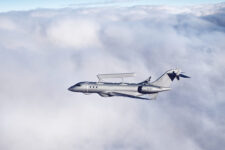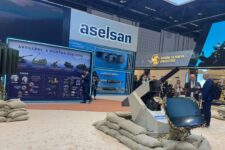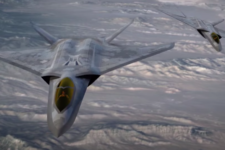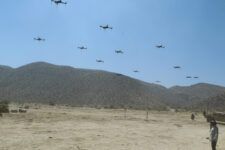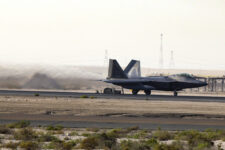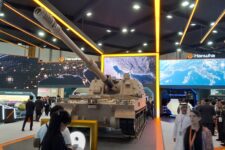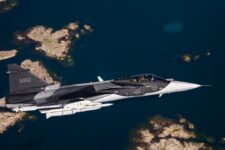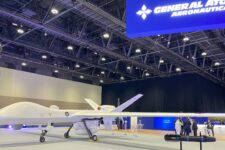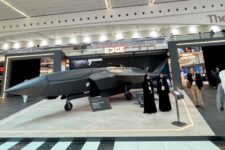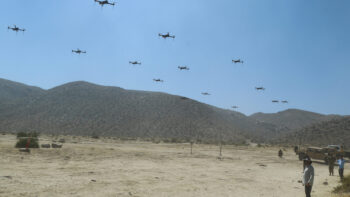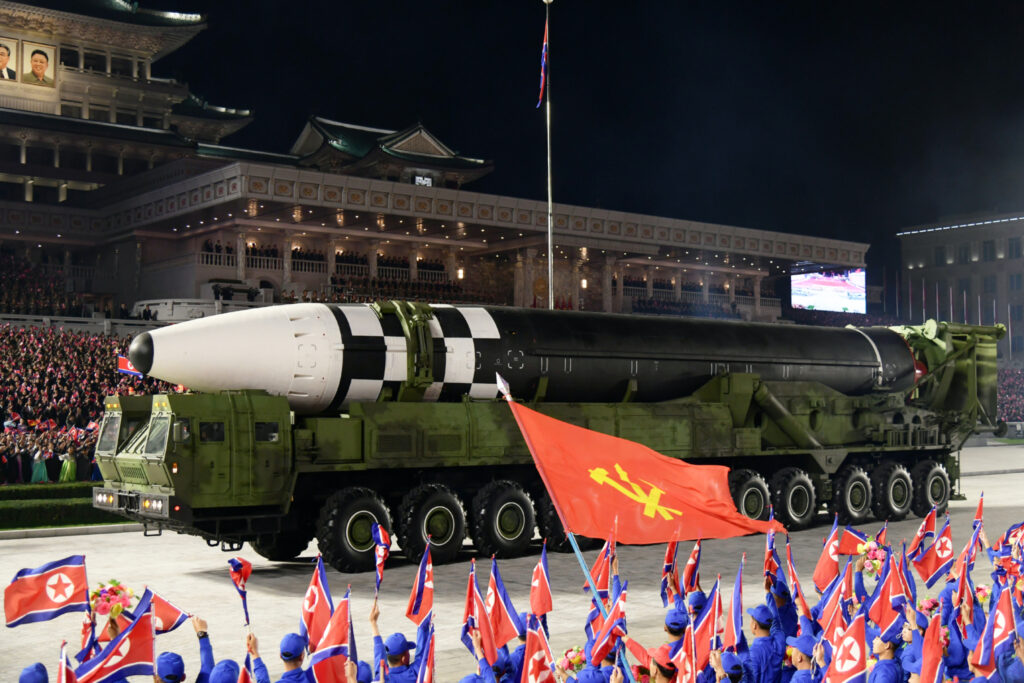
North Korea parades what appears to be a new and larger ICBM
Ralph Savelsberg has provided Breaking D readers with crucial and unique analyses of foreign missile threats over the last few years. We decided to cement the relationship and he is now a member of the Breaking Defense Board of Contributors. We are grateful that this true expert feels enough confidence in both our editing and our audience to allow us to publish these exclusive works. His latest is one of his most intriguing. What does he say about the latest and largest North Korean ICBMs? Read on! The Editor.
On October 10, the official celebration of the 75th anniversary of the Worker’s Party of Korea, North Korea rolled out four new large liquid-propellant missiles carried on 11-axle transporters.
We are not aware of an official source for the name of the new missile and the DPRK has unveiled several other missile designs since the Hwasong-15, so a provisional name is applied as the “Hwasong-XX”. In the same parade, four examples of the older Hwasong-15 missile on 9-axle transporters were on display. The Hwasong-15 was tested in 2017 in a manner indicating that it could carry a considerable payload all the way to the US East Coast. Notably, the Hwasong-XX appears to be significantly larger than the Hwasong-15.
But we need to be careful in jumping to conclusions. The DPRK has a history of parading weapon mockups that never flew. So, this parade article may serve an explicit deception/propaganda goal. Unfortunately, based on nuclear explosions conducted and the capabilities shown in the flight test of the Hwasong-15, the DPRK appears to already have an ICBM that can challenge the anti-missile systems being developed by the US. This new missile — if real — does not change the current threat or defense calculus.
In his 2018 New Year’s address, a few weeks after the Hwasong-15 launch, North Korean leader Kim Jong Un announced: “Our country’s nuclear forces are capable of thwarting and countering any nuclear threats from the United States, and they constitute a powerful deterrent that prevents it from starting an adventurous war. In no way would the United States dare to ignite a war against me and our country. The whole of its mainland is within the range of our nuclear strike and the nuclear button is on my office desk all the time; the United States needs to be clearly aware that this is not merely a threat but a reality.”
This is a clear DPRK claim of a nuclear deterrent against the US and addresses several crucial elements of such a deterrent: a delivery vehicle with sufficient range, a nuclear weapon and a command and control element, i.e. the button on Kim Jong Un’s desk. Deterring the US is considered a prerequisite for Kim’s regime survival in support of its ultimate goal of reuniting the Korean peninsula.
In accord with the 2002 justification for the Bush 2004 Ground Based Midcourse Defense deployment, the ‘DPRK was expected to field an ICBM imminently’. In December of 2012, after several failed attempts in prior years, the DPRK successfully replicated a Sputnik-style satellite launch using the Unha-3, in the same manner the Soviets used the R-7 ICBM booster. This event was dismissed by many foreign observers as not ICBM relevant, due to the size (2.4 m diameter and 90 tons), pad launch and the fact that the extended preparation time would leave the system vulnerable to attack during preparation (all solvable via silo basing). These observers may have been perceived as discrediting the system and the DPRK seems to have desired more credibility for their deterrence. Uniquely they have developed Transporter-Erector-Launchers, intended to convey the credible existence of liquid-fueled mobile ICBMs. One lesson taught by the ‘great Scud hunt’ in the 1991 Gulf War was the innate difficulty of locating and destroying a mobile missile, even when the attacking force has aerial supremacy. However, while a missile that can be driven around fuelled and armed for launching from different sites is harder to locate and destroy, the missiles that provide the required structural robustness are uniquely derived from R-17 ‘Scuds’ or are more modern solid-propellant systems.
The DPRK has displayed various designs of supposedly mobile ICBMs, all considerably smaller than the Unha-3 (or the Hwasong-XX) during prior parades. Figure 1 shows several examples. Two different designs labelled in Korean as the Hwasong-13, displayed in 2012 and 2015, respectively, appear in Figures 1a and 1b. The 2017 parade featured ‘cannisters’ potentially for solid-propellant ICBMs, shown in Figures 1c and d. While the Hwasong-13 may have represented a real design for an aspirational missile, none of these articles ever flew.
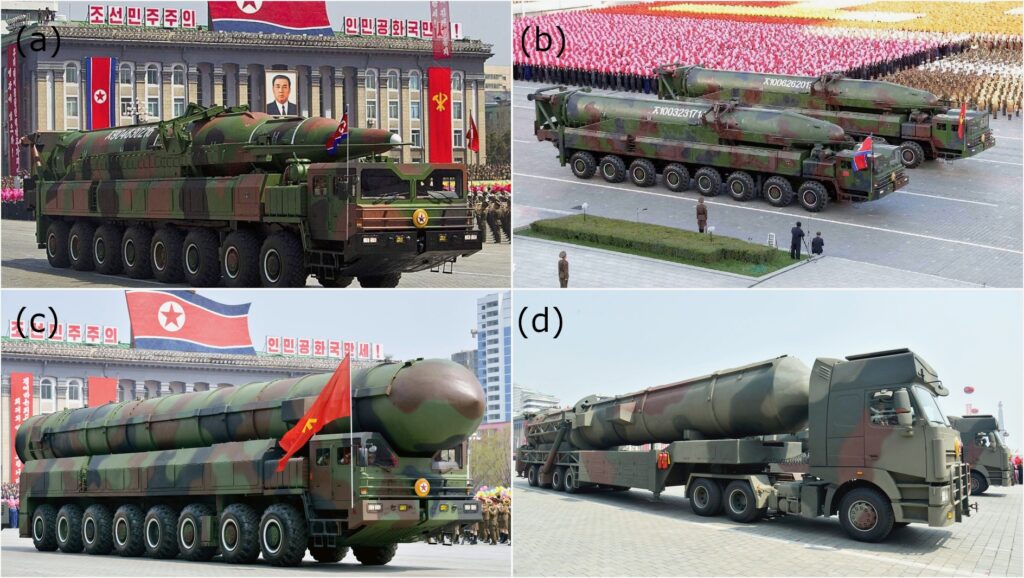
Figure 1
Figure 1: Missile transporters displayed during past parades in Pyongyang. (a) The first variant of the Hwasong-13 displayed in 2012, (b) the second Hwasong-13 displayed in 2015, (c) a transporter-erector-launcher with a launch canister for a supposed solid-propellant ICBM from 2017 and (d) a mobile erector launcher with a launch canister
The eight-axle transport vehicle above has been identified as a Chinese-built WS51200. Six of these trucks were exported to the DPRK for use in the logging industry. The same vehicles were also used to transport two subsequent missile designs. The Hwasong-14, shown in Figure 2a, was launched twice: on the 4th and 28th of July 2017. In both cases the missile flew a lofted trajectory, which reached a high altitude, but covered a relatively short distance over the surface of the Earth. The Hwasong-14 is relatively compact (smaller than the Hwasong-13, for instance). Its lofted trajectories suggest that it could fly roughly 9,000 km (enough to reach the US West Coast) if flown on a more typical ICBM trajectory, but its limited size and lengthy reported burn times suggest that the lofted trajectories were flown with very small payloads.

Figure 2: Kim Jong Un in front of a WS51200 carrying the Hwasong-14 missile (a) and the Hwasong-15 being driven through Pyongyang during a February 2018 parade, using a nine-axle version of the WS51200 (b). (Credit: Rodong Sinmun and KCNA.)
The Hwasong-15, shown in Figure 2b, was successfully launched on November 28th 2017 on a lofted trajectory that reached a higher altitude than both previous flights. Like the Hwasong-14, it is a two-stage liquid propellant missile, but it is considerably larger. To carry it, the WS51200 transporters were apparently modified with a ninth axle. Shortly after the successful flight, the DPRK announced that it could now deliver a “super-large heavy warhead to anywhere in the United States”. Published missile diameters range from 2 to 2.4 m, but the Hwasong-15 indeed is generally assessed as capable of reaching the US East Coast with a sizable warhead.
The new missile displayed during the latest parade appears to be a liquid-propellant ballistic missile that is considerably larger than the Hwasong-15. The 11 axles on its transporter indicate it is longer and its larger diameter can be measured by comparing both it and the Hwasong-15 to the width of the road that crosses the parade ground, shown below.

Figure 3: Comparisons of the width of the missile projected on the road surface, compared to the distance between lines on the pavement for TELs carrying Hwasong-15 missiles (a) and a TEL carrying the larger Hwasong-XX (b), during the October parade.
The widths of three cross sections of the cylindrical body of the Hwasong-15 were projected onto the road surface, at the appropriate length-wise positions and compared to the distance between the continuous lines that mark the edges of the road, in Figure 3a. There is some distortion due to the perspective in the vertical direction, the road is not completely level, the vehicles are not completely lined up with the road, the lines on the road may not be completely parallel, fitting circles to the markings on the missile is not perfect and there is uncertainty in the exact length-wise positions in the comparison. Nonetheless, the three values differ by only a few percent.
Compared to the width of the road, the Hwasong-XX diameter near the base of the cylindrical body (just above the flared section at the base of the missile), in Figure 3b, is 22% larger than the average number for the Hwasong-15. The diameter near the top of the checkerboard markings is also larger than that of the Hwasong-15, but, as was already obvious from the figure at the top, the booster is slightly tapered. Given its increased length and diameter, we can expect it to be roughly 80 % heavier than the Hwasong-15 when fuelled.
This all points to a missile that can potentially carry a much larger payload to the same ranges as the Hwasong-15. However, other than the gross size envelope, the uncertainties preclude appropriate assessment of the system’s capabilities and military characteristics. The missile has not flown and it is unclear which engines power it. Given its increased mass, the Hwasong-15’s twin engines do not have enough thrust to lift the larger missile off the ground. Building larger engines or a larger cluster of smaller ones is difficult. The Soviet Union spent years testing and tuning to perfect their use of clusters of similar engines on the R-36 / SS-9.
In terms of military characteristics, mobility is suspect for two major reasons. First, the missile is huge. If real, when loaded with fuel, it is at least as heavy as the Unha-3, causing problems for road and bridge capacity. Second, the addition of internal structures to survive fuelled road travel would increase the dead-weight mass fraction to something over 15%, losing a significant fraction of either the range or payload. The Hwasong-15 was reported as having been driven to its launch site and spending more than 90 minutes in preparation prior to flight; this provides a timeline for erection/emplacement, fuelling and launch activities. A properly mobile missile is armed and fuelled, ready to launch without preparations. In contrast, the Hwasong-15 and other DPRK missiles appear to have been demonstrated as being ‘transportable’, requiring fuelling and other preparation prior to launch. Clearly the perception of these systems as ‘mobile liquid ICBMs’ is flawed; engineering factors show that the “largest liquid-propellant road-mobile ballistic missile” is a bad design.
So, what is it for? A credible DPRK deterrent should take missile defenses into account. The US has the Ground-Based Midcourse Defense system (GMD), intended against limited attacks using ICBMs. It consists of a string of radars, at least 40 Ground-Based Interceptor missiles (GBI) based in Alaska, four more interceptors in California and associated command and control elements. As intended from 2002, GMD is designed to deal with a relatively unsophisticated threat, with a single re-entry vehicle per missile. The new missile’s front end shows a complicated arrangement with multiple thrusters for fairing separation and staging. This leads to an expectation that the DPRK has the ability to build a post-boost vehicle capable of deploying objects on different state vectors.
The large fairing appears to have significant volume, leading to an expectation of room for multiple re-entry vehicles. Since much of the technology for defense penetration (tailored to the Moscow defenses of the day) has been published by the UK Government (from the Chevaline project) it seems that the DPRK seeks to gain sufficient payload capacity to utilize a ‘bus’ and penetration aids to significantly challenge the US BMD system with each missile. In that case, rather than one target per missile, a missile defense system would have to deal with multiple targets, compounding the difficulties. However, the idea that the DPRK could go from a single successful flight of the Hwasong-15 with an untested re-entry vehicle to a much larger ICBM with multiple independently targetable re-entry vehicles, in a single step, beggars belief.
Unfortunately, GMD has a patchy test history. To date, in tests of the system, only 55% of the intercepts were deemed successful, according to DOT&E annual reports. This implies that, in a hypothetical North Korean attack, if one of their warheads on its way to a target in the US were engaged by a single interceptor, it has a roughly 45% probability of surviving. Lowering the probability that a warhead penetrates the defenses to a more acceptable, much lower number than 45% will therefore require multiple interceptors being fired against every object that could be an incoming warhead. Improved interceptors now being developed may improve the probability of them hitting their targets, which would reduce the number of interceptors required. However, the probabilities of multiple successive interceptors hitting a target are not independent: if a single attempt at intercepting a particular target fails due to a systematic error, it is entirely reasonable to expect the others to fail against that particular target as well. Finally, GMD has never been tested under combat conditions, so the success rate in the tests may actually be higher than what can be expected in a real attack.
Even though the Hwasong-15 can hardly be considered operational after a single test flight, it is a real missile.Bearing GMD’s limitations in mind, if it were to become operational and be rigorously tested a relatively small number of Hwasong-15s with suitable warheads would represent a credible threat.
The new Hwasong-XX, however, may simply not be real. We lack insight into its capabilities and limitations, as well as the manufacture of the truck that carried it. Indeed, from what was shown on October 10th, it could have been built to merely carry empty shells from the staging area to the parade ground and back, using parts from different vehicles. It may be an elaborate ruse to convince the US and the US public of the viability of the DPRK’s deterrent via road-mobility, as opposed to a missile hidden in a covert silo. While relations between the US and the DPRK apparently improved after the 2018 Singapore summit meeting between Kim Jong Un and US President Donald Trump, there has been little progress since. This parade may have been intended to influence US behaviors in an uncertain time but entails less risk than performing a test flight with the DPRK’s existing ICBM.
Ralph Savelsberg is an associate professor at the Netherlands Defence Academy, specializing in missile defense. This article does not reflect any official position or policy of the Government of the Netherlands. The author would like to thank James Kiessling for his valuable comments and suggestions.
As DoD shifts $50B in spending, can an old playbook protect legacy programs?
Running through potential winners and losers under Defense Secretary Pete Hegseth’s move to shift $50 billion towards different priorities in fiscal 2026.


